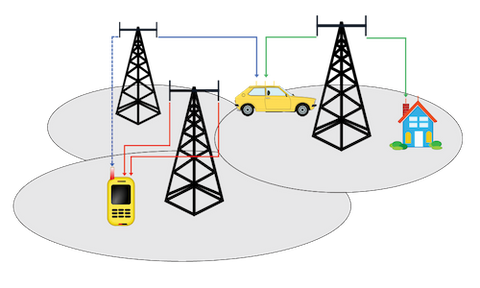Multiple Input / Multiple Output (MIMO) for Faster Mobile Data
May 12, 2016

When mobile phones are used in an urban area, the RF signal between the base station antenna and the handset often has to bounce off many buildings along the route. This is called multi-pathing, a phenomenon that was in the past seen as being bad for good RF communications. MIMO is a RF transmission technology that uses this reality to turn multi-pathing into a way to increase the data rates and data capacity of mobile devices.
MIMO is a radio system that has multiple inputs and outputs and uses multiple antennas on both ends of the link. Several communication system algorithms and architectures fall under the broad category of MIMO, including beamforming and massive MIMO. Modern LTE systems deploy a type known as "spatial multiplexing". This is often what the wireless industry refers to when the term MIMO is used.
A new generation of wireless technologies as well as LTE and LTE-Advanced make data intensive applications such as gaming and mobile video possible. MIMO connections get more use from the bandwidth available by using multiple channels. This enables these types of applications.
Instead of using a single channel, MIMO establishes multiple connections between a user and the network by using the same frequency band in two or four channels. MIMO does not avoid multi-pathing, but deliberately finds multiple paths for RF signals.
MIMO can only work if multiple receivers, transmitters and antennas are installed into each mobile device. In a MIMO-enabled network, a mobile device will send and receive two separate wireless signals instead of one.
In a MIMO network, the base station antennas can receive more than one signal. MIMO connections use advanced signal processing algorithms and innovative engineering to avoid the negative effects of multi-pathing. At the same time, the speed at which users can watch videos, play games and access the internet is increased significantly.
Any Comments? Please share your comment below.
Share this post
5 comments


There seems to be no shortage of methods for improving cell phone signals but if I’ve learned one thing from browsing this site, I’ve learned that it depends on your needs. If you have no cell signal, a booster won’t help. If you have a weak signal, chances are a booster will help.
You’re certainly not the first person to ask, “How do I fix the ‘no service’ error on my Verizon phone?” First, try rebooting your phone. This may help get you back to where you want to be without any unnecessary trips to the store. Second, try switching to Airplane Mode, then switching back to regular mode. Check with your account, there may be a missed payment or an error recording a payment. Also, check your phone to make sure it has all the latest updates. If these don’t work, you may just have a defective phone. Check to see if there are any recalls or such.
Amazing how things keep improving. Question though—how do I fix the ‘no service’ error on my Verizon phone?
When I first saw Massive MIMO, I thought “World of Warcraft.” However, all kidding aside, this blog does have to do with gaming as a MIMO antenna design can help you in situations where you need to use a lot of bandwidth. It really is cool how the MIMO in LTE systems works in utilizing multiple connections. I’d ask what will they think of next, but when it comes to cell phone boosters and related tech, the scientists continue to amaze me.
Can anyone tell me if these MIMO systems are comparable to the different channels available on the old citizen band radios? It sounds like cell phone networks are doing anything to get the most out of their signals. This reminds me of relay stations in ham radio operations too where you bounce signals to get further range. Would this MIMO work for DAS designs too or is it an apples and oranges thing?